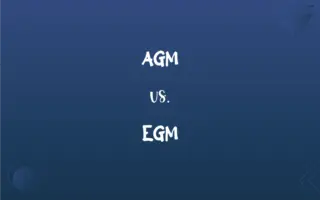WWI vs. WWII: What's the Difference?
Edited by Aimie Carlson || By Janet White || Published on February 13, 2024
WWI (1914-1918) was a global conflict primarily in Europe, sparked by nationalism and alliances, while WWII (1939-1945) involved broader ideological struggles, including fascism versus democracy.

Key Differences
WWI, occurring from 1914 to 1918, was characterized by trench warfare and was largely a European conflict with global ramifications. WWII, spanning from 1939 to 1945, involved greater global participation and was marked by significant battles across multiple continents.
The causes of WWI included complex alliances, nationalism, and the assassination of Archduke Franz Ferdinand. In contrast, WWII was largely fueled by the rise of totalitarian regimes in Germany, Italy, and Japan, and their aggressive expansionism.
WWI saw the collapse of empires such as the Ottoman and Austro-Hungarian, while WWII resulted in the downfall of Nazi Germany and Imperial Japan, leading to the restructuring of global power.
Technologically, WWI witnessed the introduction of tanks and chemical warfare, whereas WWII saw advancements like nuclear weapons and more sophisticated aircraft and tanks.
The aftermath of WWI, including the Treaty of Versailles, set the stage for WWII, which ultimately led to significant political changes, including the establishment of the United Nations and the beginning of the Cold War.
ADVERTISEMENT
Comparison Chart
Duration
1914-1918
1939-1945
Main Causes
Nationalism, alliances, assassination
Totalitarianism, expansionism
Key Technologies
Tanks, chemical warfare
Nuclear weapons, advanced aircraft, sophisticated tanks
Global Impact
Collapse of empires, redrawing of borders
Restructuring of global power, United Nations formation
Aftermath
Treaty of Versailles, geopolitical changes
Cold War onset, decolonization, economic reconstruction
ADVERTISEMENT
WWI and WWII Definitions
WWI
A global conflict primarily centered in Europe.
WWI reshaped European and global politics.
WWII
Led to the establishment of the United Nations.
WWII's end marked the beginning of the United Nations.
WWI
Characterized by trench warfare and high casualties.
The trench warfare in WWI resulted in unprecedented losses.
WWII
Saw significant battles on multiple continents.
WWII battles raged from Europe to the Pacific.
WWI
Ended with the Treaty of Versailles in 1919.
The Treaty of Versailles in 1919 officially concluded WWI.
WWII
A global war marked by the rise of fascism and total war.
WWII was a struggle against fascist regimes.
WWI
Involved the collapse of several empires.
WWI saw the end of the Ottoman Empire.
WWII
Resulted in the downfall of Nazi Germany and Imperial Japan.
The defeat of Nazi Germany was a pivotal moment in WWII.
WWI
Sparked by complex alliances and nationalism.
Nationalism played a significant role in triggering WWI.
WWII
Featured the use of nuclear weapons and blitzkrieg tactics.
Nuclear weapons were first used in WWII.
FAQs
What were the main causes of WWI?
Nationalism, complex alliances, and the assassination of Archduke Franz Ferdinand.
Which empires collapsed because of WWI?
The Ottoman and Austro-Hungarian Empires, among others.
When did WWI take place?
WWI lasted from 1914 to 1918.
When did WWII occur?
WWII lasted from 1939 to 1945.
What new weapons were introduced in WWI?
Tanks and chemical warfare were significant innovations.
How did WWII end?
With the defeat of Axis powers and the surrender of Japan in 1945.
How did WWI end?
With the Treaty of Versailles in 1919.
Which countries were the primary aggressors in WWII?
Germany, Italy, and Japan.
What significant technology was used in WWII?
Nuclear weapons and advanced aircraft.
How did WWII impact the global power structure?
It led to the decline of colonial empires and the rise of the US and USSR as superpowers.
What was the role of the US in WWI and WWII?
The US joined WWI in 1917 and was a major Allied power in WWII from 1941.
How did WWII affect women's roles?
Women took on many roles traditionally held by men, changing perceptions of gender roles.
What were the main causes of WWII?
The rise of totalitarian regimes and aggressive expansionism.
Did WWI directly lead to WWII?
Yes, the consequences of WWI, especially the Treaty of Versailles, set the stage for WWII.
What was trench warfare in WWI?
A type of warfare characterized by deep trenches to protect soldiers from enemy fire.
What was the League of Nations, and how is it related to WWI?
It was an international organization formed after WWI to prevent future conflicts.
What was the Holocaust in WWII?
The genocide of six million Jews by Nazi Germany.
How did WWI affect civilian populations?
It led to significant civilian casualties and hardship, especially in Europe.
What were the economic effects of WWI and WWII?
Both wars led to massive economic strain and post-war reconstruction needs.
Were chemical weapons used in WWII?
They were largely not used, despite being developed.
About Author
Written by
Janet WhiteJanet White has been an esteemed writer and blogger for Difference Wiki. Holding a Master's degree in Science and Medical Journalism from the prestigious Boston University, she has consistently demonstrated her expertise and passion for her field. When she's not immersed in her work, Janet relishes her time exercising, delving into a good book, and cherishing moments with friends and family.
Edited by
Aimie CarlsonAimie Carlson, holding a master's degree in English literature, is a fervent English language enthusiast. She lends her writing talents to Difference Wiki, a prominent website that specializes in comparisons, offering readers insightful analyses that both captivate and inform.








































































